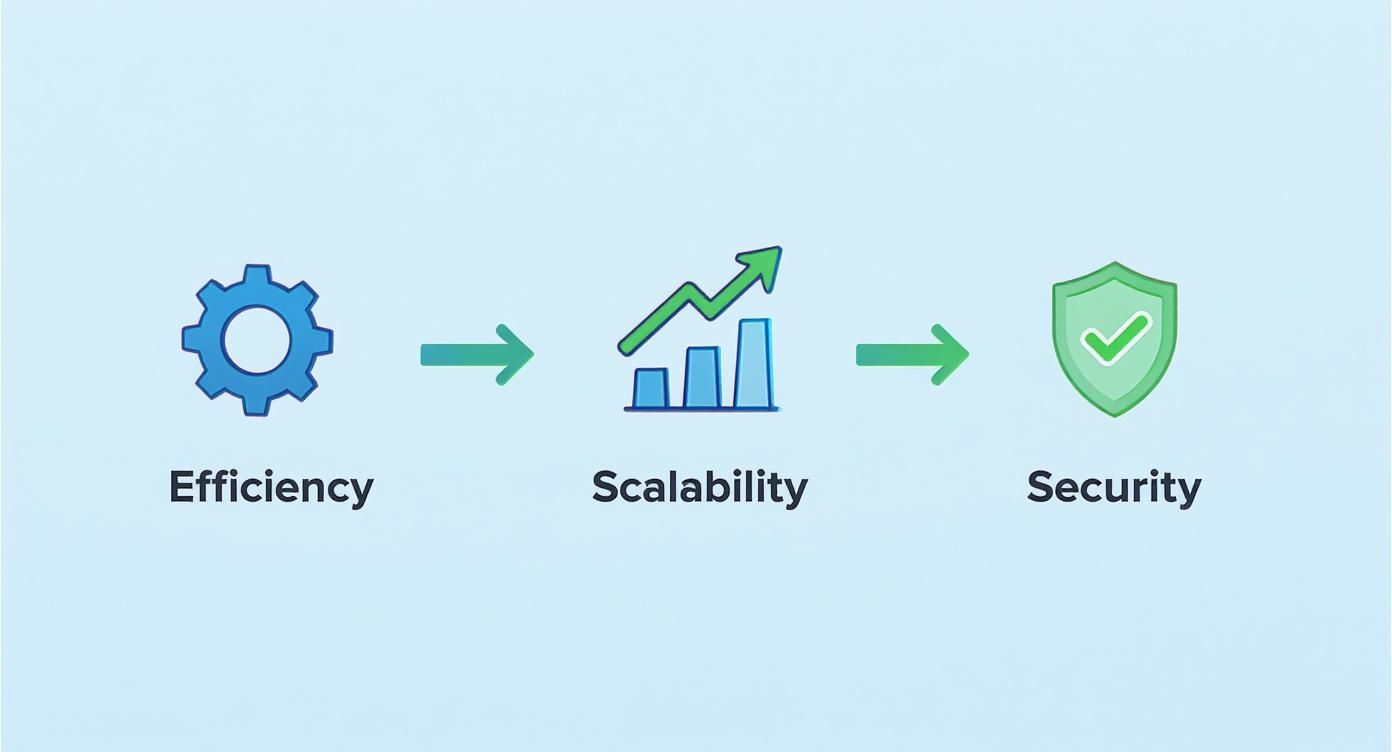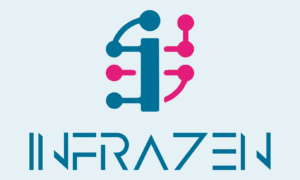Bespoke software development is all about creating a software solution that’s designed from the ground up for one specific organisation. Think of it like getting a suit tailor-made; it’s crafted to your exact measurements and needs, unlike something you'd just grab off the rack. This custom-fit approach ensures every single feature serves a clear purpose for your business.
What Is Bespoke Software Development?

You’ll know it’s time to consider bespoke software when off-the-shelf solutions just aren’t cutting it anymore. Pre-packaged software is built for the masses, which means it’s often bloated with features you don’t need while missing the specific functions your team actually relies on. This inevitably leads to clunky workarounds and kills productivity.
Custom-built software, on the other hand, is engineered to fit your existing workflows, not force you into new ones. The whole process is a partnership. You work directly with developers to nail down your goals, map out how people will use the system, and build something that solves your exact problems. The end result feels natural and perfectly aligned with how your business already runs.
The Purpose of a Custom Approach
The main goal here is to create a real competitive advantage. When you have a tool that no one else has, you can deliver a better customer experience, automate uniquely complex processes, or analyse data in completely new ways. You just can't get that edge from a generic product.
For example, a creative agency might commission a custom project management system. This system could seamlessly integrate client feedback, artist timesheets, and invoicing into a single, slick platform-something no off-the-shelf tool could ever do so perfectly.
Bespoke software is not just about creating a tool; it's about building a strategic asset. Because you own the intellectual property, you have complete control over its future. You can adapt, scale, and enhance it as your business evolves, without being held hostage by a third-party vendor's limited roadmap.
To get a clearer picture, let's compare custom solutions with their off-the-shelf counterparts side-by-side.
Bespoke Software vs Off-the-Shelf Solutions
| Feature | Bespoke Software | Off-the-Shelf Software |
|---|---|---|
| Functionality | Built precisely for your needs-no more, no less. | Generic features for a broad audience. |
| Scalability | Designed to grow and adapt with your business. | Limited by the vendor's development plan. |
| Integration | Easily integrates with your existing systems. | Can be difficult or impossible to integrate. |
| Ownership | You own the intellectual property and code. | You only license the software; you don't own it. |
| Initial Cost | Higher upfront investment. | Lower initial cost, often subscription-based. |
| Long-Term ROI | Higher, due to improved efficiency and scalability. | Can be lower due to ongoing fees and limitations. |
| Support | Dedicated support from the development team. | General support serving thousands of customers. |
While the initial cost is higher, the long-term value of a bespoke system often far outweighs the quick-fix appeal of a pre-packaged solution.
The Growing Demand for Custom Solutions
The shift towards custom software is undeniable. The UK software development industry is booming, with the market projected to grow at a compound annual growth rate (CAGR) of 20.2% through 2030. This isn't just a trend; it's a strategic move by businesses who realise that investing in personalised systems delivers far more long-term value than relying on generic ones.
A well-designed bespoke application becomes one of the core information systems for business that fuels growth and innovation. It can help you:
- Improve Efficiency: Automate tedious tasks and streamline your most complex operations.
- Enhance Scalability: Build a system that can handle growth without creaking at the seams.
- Strengthen Security: Implement security protocols designed specifically for your data and compliance needs.
Ultimately, choosing bespoke software is an investment in a solution that truly works for you-not just one that works.
The Strategic Benefits of Custom Software
Opting for bespoke software isn't just about convenience; it's a strategic move that unlocks some serious advantages. Instead of trying to shoehorn your operations into a rigid, off-the-shelf product, a custom solution is built from the ground up to support the exact processes that make your business tick. This creates a powerful foundation for growth and sharpens your operational edge.
The first thing you'll notice is a huge leap in efficiency. Generic software has to cater to everyone, which means it’s usually bloated with features you don't need while missing the specific tools you're desperate for. This mismatch forces your team into clumsy workarounds and manual data entry, wasting time fighting against software that just doesn't get them.
Gaining a True Competitive Edge
B bespoke software puts an end to all that frustration. When you design workflows around your precise operational needs, you can automate those soul-destroying repetitive tasks, slash human error, and free up your people to focus on work that actually adds value.
Think about a project management tool for a creative agency that automatically pulls client feedback from emails, tracks artist hours against project milestones, and generates invoices-all in one seamless flow. You just can't get that level of tailored automation from a generic tool.
This gives you a real competitive advantage. When your systems are faster, more intuitive, and better integrated than your competitors', you can deliver better results for clients, get ideas to market quicker, and stay far more agile.
A custom-built application is more than just a piece of software-it's a strategic asset that moulds to your business. It allows you to innovate on your own terms, creating unique customer experiences or internal processes that competitors using generic tools simply cannot replicate.
Built for Scalability and Security
Another massive win is scalability. Off-the-shelf solutions often creak and groan as a business grows. You might hit a user limit, find the database can't handle the new volume of work, or discover it won’t play nicely with the new systems you need for your expansion.
A bespoke solution, on the other hand, is built with your growth plans in mind. Its architecture is designed from day one to handle increasing loads, and it can be easily modified or expanded as your business evolves. It ensures your tech is an enabler of growth, not a barrier to it. This is a core part of achieving technology alignment in your IT strategy, making sure your tools support your long-term vision.
Security also gets a major boost. With a custom build, you have total control over the security protocols. You can implement measures specific to your data and compliance needs, which is a world away from the one-size-fits-all security of generic software that might not address your specific risks.
Maximising Long-Term Return on Investment
While the upfront cost of bespoke software is higher, it often delivers a much better long-term return on investment (ROI). Why? Because you're not paying recurring licence fees for software packed with features you never touch. You're investing in a permanent asset that you own outright.
Businesses are already seeing the payoff. By automating routine tasks and integrating smart analytics, companies are banking significant time and cost savings. Those adopting custom-built solutions aren't just making their operations more efficient; they're future-proofing their business against market shifts, new regulations, and emerging cyber threats.
Navigating The Software Development Lifecycle
Turning a great idea into a fully working piece of software isn’t a single leap of faith; it’s a structured journey. The bespoke software development lifecycle is the roadmap that guides your concept through clear, organised stages, making sure nothing gets missed and the final product does exactly what you need it to do. Think of it as breaking down a huge project into manageable, logical phases.
Getting your head around this lifecycle means you can work confidently with your development partner and set realistic expectations right from the start. Each stage, from the initial brainstorming sessions to long-term support, has a specific purpose. It’s all designed to turn abstract requirements into tangible, high-quality software.
This infographic shows how bespoke software helps businesses hit key goals through a focused development process.

It neatly highlights how custom-built software directly translates into better efficiency, smoother scalability, and stronger security-the three pillars of any solid operational foundation.
Stage 1: Discovery And Strategic Planning
Every truly successful project starts by digging deep into the 'why'. The discovery phase is where your development partner gets to know your business inside and out-your goals, your frustrations, and the specific problem you’re trying to solve. This isn't just about tech; it's about making sure everyone is strategically aligned.
This stage is packed with activity, from stakeholder interviews and competitor analysis to workshops that map out what users actually need. The result is a detailed project scope, a technical specification document, and a clear roadmap with timelines and milestones. Honestly, this initial planning is the most critical part of the entire lifecycle. It lays the groundwork for everything that comes next.
A well-executed discovery phase ensures that what gets built is not just technically sound but also strategically valuable. It prevents costly misunderstandings and scope creep later on by establishing a shared vision and a single source of truth for the entire team.
Stage 2: UI/UX Design
With a solid plan locked in, the focus shifts to how the software will look and feel. This is where user experience (UX) and user interface (UI) design come in. UX is all about the overall feel of the application-is it intuitive, efficient, and even enjoyable to use? UI, on the other hand, is the visual side of things-the look of the buttons, icons, and screens that people will actually interact with.
During this stage, designers will create wireframes (think of them as basic blueprints) and then move on to high-fidelity mockups, which are detailed visual designs. These are often turned into interactive prototypes, allowing you to click through the app before a single line of code has been written. It’s the perfect time to gather feedback and make tweaks, ensuring the final product is both beautiful and functional.
Stage 3: Development And Testing
This is where the magic happens. The designs and plans are brought to life as developers write the code, build the database, and connect any necessary third-party services. This phase is usually broken down into smaller, manageable chunks called 'sprints', which typically last two to four weeks. At the end of each sprint, a working piece of the software is delivered for you to review.
Running alongside development is rigorous testing, also known as Quality Assurance (QA). Testers are there to hunt down and report bugs, check that features meet the original requirements, and make sure the application is secure and performs well under pressure. This usually includes:
- Functional Testing: Verifying that each feature works as expected.
- Usability Testing: Ensuring the software is easy for end-users to navigate.
- Performance Testing: Checking speed, responsiveness, and stability under a heavy load.
- Security Testing: Identifying and fixing potential vulnerabilities.
Stage 4: Deployment And Ongoing Maintenance
Once the software has been thoroughly tested and given the green light, it's time to go live. Deployment is the carefully managed process of moving the application from the development environment to a live server where your users can access it.
But the journey doesn't end at launch. Like any valuable asset, bespoke software needs ongoing support and maintenance to stay effective. This means fixing any bugs that pop up after launch, performing regular security updates, and making performance tweaks. A solid life cycle risk management strategy ensures your software remains robust and secure long after its initial release. This ongoing partnership with your development team is what guarantees the long-term success and value of your custom software.
Understanding The Costs Of Bespoke Software
Let’s talk about the big question: how much does bespoke software actually cost? Unlike grabbing a piece of off-the-shelf software with a clear price tag, custom software doesn’t have a simple, fixed number. Think of it less as a purchase and more as an investment-the cost reflects the time, expertise, and resources needed to build something that fits your business like a glove.
Several key factors shape the final budget. Getting your head around these variables helps you see exactly where your investment is going and plan your finances with more confidence.
Key Factors That Influence The Budget
The single biggest driver of cost is project complexity. It's only natural that a simple internal tool for tracking tasks will cost less than a sophisticated, customer-facing platform with real-time data processing and e-commerce functions. The more features you need, the more development hours it takes. Simple as that.
Next up is the technology stack-the mix of programming languages, frameworks, and databases used to build your software. Some technologies require developers with highly specialised skills, and that expertise comes at a premium. Likewise, if you need complex integrations with existing systems like your CRM or ERP, that will add to the development timeline and, you guessed it, the cost.
Other important cost factors include:
- Team Size and Structure: The number of developers, project managers, designers, and QA testers on the job will naturally shape the budget.
- UI/UX Design Complexity: A highly polished, custom-designed user interface with intricate animations demands more design and front-end development time than a simpler, more functional design.
- Ongoing Support and Maintenance: The project doesn’t just stop at launch. You need to budget for ongoing support, security updates, and future improvements to keep the software healthy and valuable in the long run.
A common mistake is to see bespoke software as a one-off expense. It’s much more accurate to view it as a capital investment that needs a plan for ongoing maintenance-just like any other critical business asset-to ensure it keeps delivering value and stays secure.
Common Pricing Models Explained
To manage all these variables, development partners usually offer a few different pricing models. Each comes with its own pros and cons, and the right choice really depends on your project's specific needs, how clear your scope is, and how much flexibility you want.
Picking the right engagement model is a critical decision. It sets the financial and operational tone for the whole project, so understanding how each one works is essential for a successful partnership.
Comparing Bespoke Development Pricing Models
Let’s break down the three most common models. Knowing how they stack up will make it much easier to decide which one aligns with your goals and budget.
Common Pricing Models for Bespoke Development
| Pricing Model | Best For | Pros | Cons |
|---|---|---|---|
| Fixed Price | Projects with a clearly defined, unchanging scope and detailed requirements. | Predictable budget and clear deliverables from the outset. | Inflexible-changes often require renegotiation and extra costs. High risk of scope creep disputes. |
| Time and Materials | Projects with evolving requirements or those where the full scope is not known upfront. | High flexibility to pivot and adjust features. You only pay for the actual work done. | Budget can be less predictable and may exceed initial estimates if not managed carefully. |
| Dedicated Team | Long-term, complex projects that require deep integration with your in-house team. | A fully committed team acts as an extension of your own, offering deep product knowledge and consistency. | Higher long-term cost commitment and requires more management from your side. |
Ultimately, the cost of bespoke software is tied directly to the value it creates. While a Fixed Price model gives you predictability, the Time and Materials approach often provides the flexibility needed for genuine innovation. For creative teams embarking on a major software project, a transparent and collaborative financial model is the key to building a solution that drives real, lasting business growth.
How To Choose The Right Development Partner

Your project’s success isn’t just down to the idea-it’s about the people who bring it to life. Picking the right development partner for your bespoke software is a huge decision. It will shape everything from your budget and timeline to the quality of the final product.
A great partnership goes way beyond technical skills. You’re looking for a team that gets your business vision and can translate it into a strategic asset that actually works. This means looking past the polished sales pitches to find a team that genuinely aligns with your goals and feels like an extension of your own.
Evaluate Technical Expertise And Industry Experience
First things first: can they actually build it? A flashy portfolio is a decent start, but you need to dig deeper. Ask for specific examples of projects that are similar to yours in complexity, scale, or the technologies involved. Do they have real, demonstrable experience building the kind of solution you need?
Just as important is their experience in your industry. A team that already understands the quirks of creative agencies or consulting firms will get up to speed much faster. They’ll be familiar with your workflows and client expectations, which cuts down the learning curve and leads to a much better end product.
A partner’s technical skill gets the job done, but their industry experience ensures it gets done right. They shouldn’t just build what you ask for; they should be able to challenge your assumptions and suggest improvements based on what they know about your world.
Assess Communication And Project Management
How a potential partner communicates is a massive clue as to how the project will run. Look for a team that’s transparent, responsive, and clear in their explanations. They need to be able to break down complicated technical ideas into plain English that makes sense to everyone, not just the tech-savvy people in the room.
Their project management style is also key. Whether they use Agile, Scrum, or something else, it should encourage collaboration, flexibility, and regular updates. You need a process that’s structured enough to keep the project on track but adaptable enough to handle the inevitable changes that come with building something new.
Key Questions To Ask Potential Partners
Before you sign anything, arm yourself with questions that reveal a team’s true process and values. This is your chance to see if they’re a good fit for a long-term relationship.
Here’s a checklist of what to ask:
- Design and Testing: "Can you walk me through your UI/UX design process? What does your quality assurance and testing protocol look like?"
- Intellectual Property: "Who will own the intellectual property and source code when the project is finished? How is this formalised in your contracts?"
- Post-Launch Support: "What do your maintenance and support packages include after the software goes live? How do you handle bug fixes and future updates?"
- Team Collaboration: "Who will be my main point of contact? How often can I expect to get progress reports and be involved in reviews?"
The demand for custom software is growing fast, and for many, that journey starts by exploring options like Custom Software Development Outsourcing. A recent survey of over 2,000 UK professionals found that analytics and decision-making tools are now more than 200% more important to businesses than before, highlighting a major shift in where companies are putting their money.
Key Considerations Before Starting Your Project
Jumping into a bespoke software project is a serious commitment. Before you get started, it's worth running a final readiness check to make sure you’re set up for success from day one. This isn't just about the tech; it's about making sure the whole initiative aligns with your wider business strategy to get the best possible return on your investment.
A clear vision is non-negotiable. Without one, you’re steering a ship without a rudder, drifting off course and wasting time and money. Your business objectives need to be crystal-clear, measurable, and understood by everyone involved. What specific problem will this software solve? And how will you measure its success-is it about boosting productivity, driving sales, or improving customer retention?
Define Your Objectives and Secure Buy-In
Committing to a full-scale bespoke build is a big step. It’s often smarter to start with a Minimum Viable Product (MVP). An MVP lets you test the core idea with real users without having to build the entire system first. You can learn more about how to build an MVP and see how it helps you validate your concept efficiently. This iterative approach means you can refine your goals based on actual feedback, not just assumptions.
Just as important is getting genuine buy-in from all stakeholders. This is about more than just a signature from management. The people who will actually be using the software day-in, day-out need to be part of the conversation from the very beginning. Their insights are priceless for shaping a tool that genuinely makes their work easier, rather than something that feels forced upon them.
Assess Your Internal Capacity and Plan for Adoption
Take an honest look at your internal team. Do you have the time and people available to dedicate to this project? A bespoke build is a collaboration. It needs your active input-you’ll be giving feedback, attending meetings, and getting involved in testing. Appointing a dedicated internal project lead can make all the difference.
On top of that, a brilliant piece of software is completely useless if nobody uses it properly. You need a solid plan for user adoption and training long before you even think about a launch date. This plan should include:
- Comprehensive Training: Schedule sessions designed for different user groups so everyone feels confident with the new system.
- Clear Documentation: Create easy-to-find guides and resources that people can refer back to whenever they need them.
- Ongoing Support: Set up a clear channel for users to ask questions and report any issues after the software goes live.
Framing your bespoke software as a strategic business initiative-not just an IT project-is the key to unlocking its full potential. A well-prepared organisation is one that has defined its goals, united its team, and planned for a smooth transition.
Finally, remember you’re creating a valuable asset. It is vital to have a clear agreement on who owns the final product. Understanding how to protect intellectual property is a critical step that secures your investment and gives you complete control over your new software's future.
Got Questions? We've Got Answers
Stepping into the world of custom-built software naturally brings up a few questions. How long will it take? What’s the real cost? Who actually owns it when it’s done?
Here are some straightforward answers to the questions we hear most often, helping you get a clear picture before you dive in.
How Long Does It Take To Develop Bespoke Software?
The honest answer? It depends entirely on the project's complexity. A simple internal tool or a Minimum Viable Product (MVP) to test a concept might be ready in three to six months.
On the other hand, a large-scale, enterprise system with complex integrations and dozens of features could easily take a year, sometimes longer. A good development partner will always kick things off with a discovery phase. This is where they map out the full scope and give you a detailed project roadmap with clear milestones, so you have a realistic timeline from day one.
Is Bespoke Software More Expensive Than Off-the-Shelf?
Upfront, yes. The initial investment for a custom solution is higher than buying a licence for a ready-made product. But the real story is in the total cost of ownership.
Off-the-shelf software usually comes with recurring subscription fees, and you’re often paying for a bundle of features your team will never touch. Bespoke software is a one-time capital investment that pays for itself over time. It’s built to fit your workflow perfectly, boosting efficiency and cutting out the endless cost of features you don’t need.
One of the biggest wins with bespoke software is that you own a genuine business asset. You're not just renting a tool; you're investing in a solution that grows with you, delivering lasting value without the endless cycle of subscription fees.
Who Owns The Intellectual Property Of Bespoke Software?
In almost every case, the client who commissions and pays for the work owns the intellectual property (IP), including all the source code. This is a massive advantage. With off-the-shelf software, you’re just licensing the right to use it.
It’s crucial to get IP ownership clearly stated in your contract before a single line of code is written. Full ownership gives you the freedom to modify, scale, or even sell the software down the line. It secures your investment and gives you complete control over your technological future.
At InfraZen Ltd, we help creative businesses build reliable and future-proof technology platforms that support their vision. If you need a strategic partner to guide your next software project, let's talk about creating a solution that works for you. Learn more about our IT management and strategy services.

